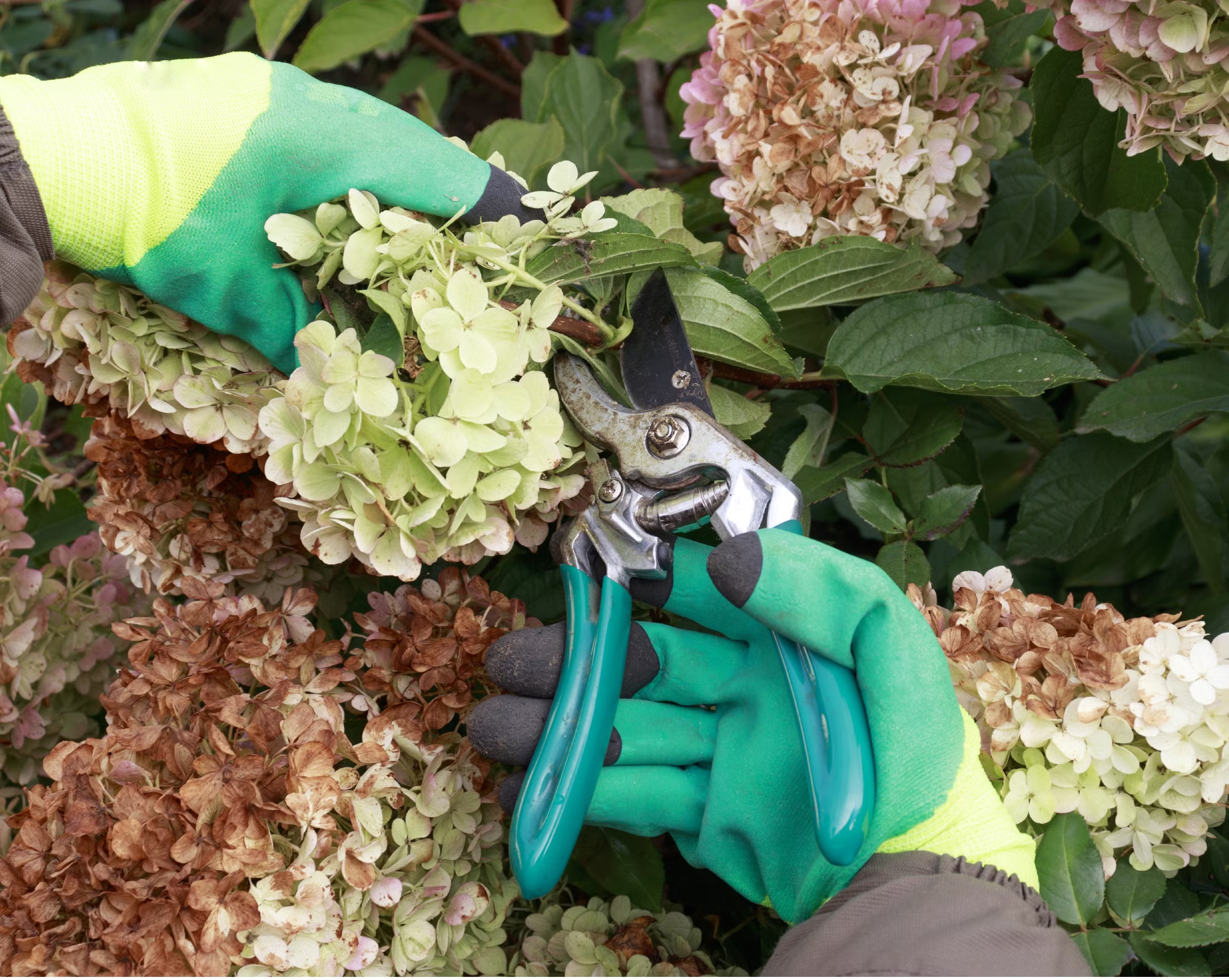The Best Time to Prune Hydrangeas in New Hampshire’s Seacoast
October on the Seacoast
October brings cooler air, soft light, and fading color to gardens across Rye, Hampton, and Portsmouth. As hydrangea blooms dry to shades of tan and pink, many homeowners feel tempted to start pruning. But this is the time to pause, not cut. On the Seacoast, where sandy soils drain quickly and ocean winds stay brisk, pruning in October can remove next year’s flower buds or leave stems exposed to winter stress. Understanding which hydrangeas you have and how they respond to local conditions will help you keep them healthy until spring.
What’s Happening and Why
By mid-fall, hydrangeas are shifting their focus underground. As daylight shortens and soil temperatures drop, these shrubs stop producing new growth and start storing energy in their roots for winter. Any pruning at this stage sends mixed signals to the plant, often triggering a late flush of tender shoots that will be killed by the first hard frost. Once those buds die back, the plant must spend extra energy repairing itself rather than resting through winter.
On the Seacoast, this stress is compounded by the coastal microclimate. Unlike inland areas, where cold sets in steadily, coastal temperatures swing between warm afternoons and sudden frosty nights. Hydrangeas that are pruned too late become vulnerable to desiccation from ocean winds and salt exposure. Old-wood hydrangeas such as Hydrangea macrophylla and Hydrangea quercifolia already hold next year’s flower buds at the tips of their stems by October. If you prune now, you will remove those buds and lose the next season’s display. New-wood types, such as Hydrangea paniculata and Hydrangea arborescens, will not need pruning until late winter or early spring when they begin new growth.
Knowing which kind of hydrangea you have is the foundation of proper pruning. Bigleaf and oakleaf hydrangeas require light pruning immediately after they finish blooming in midsummer, while panicle and smooth hydrangeas benefit from a stronger cut back in early spring. Pruning in October, however, disrupts both cycles and reduces overall plant vigor.
The Plant or Garden Impact
Pruning hydrangeas in October often leads to fewer blooms the following summer. Homeowners sometimes mistake dried flower heads or salt-burned stems for dead wood and trim too much. Those cuts remove next year’s buds and expose tender tissue just as frost arrives. On the Seacoast, where nights cool faster near the ocean, buds that remain intact through fall tend to produce fuller, more even flowers in spring.
What Expert Gardeners Recommend
At Expert Pruning, we recommend finishing all pruning of old-wood hydrangeas by early to mid-August. Once October arrives, focus on maintenance rather than cutting. Leave the dried flower heads on the plant—they act as natural insulation and prevent the stems from drying out in the wind. If you need to tidy the shrub, remove only the spent blooms at the very top without trimming into the wood below.
For panicle and smooth hydrangeas, patience pays off. Wait until late March or early April to prune them. At that time, cut the stems back by about one-third to one-half their height. This promotes new growth and stronger flowering stems. Along the Seacoast, this approach helps hydrangeas stand up better to wind and salt exposure through the year. Always use clean, sharp tools and make cuts at a slight angle just above a healthy bud. Finish by adding a light mulch or compost top-dressing to keep the soil protected and enriched.
Adapting and Alternatives
If your hydrangeas have outgrown their space or become difficult to manage, consider selective rejuvenation rather than hard pruning. Remove a few of the oldest stems at ground level each year to gradually renew the plant. For homeowners who prefer a low-maintenance garden, coastal-tolerant varieties such as Hydrangea paniculata ‘Limelight’ or Hydrangea arborescens ‘Annabelle’ perform reliably with minimal shaping. Both are excellent options for Zone 6b gardens and stand up well to salt spray and variable weather.
Some homeowners also choose to create sheltered planting spots for hydrangeas. Placing them near fences, hedges, or evergreens helps block cold winds and protects buds from damage. This small change in microclimate can extend the lifespan and flowering power of your plants.Garden Resilience and Local Support
Each Seacoast property has its own rhythm. Gardens near downtown Portsmouth stay milder than those in North Hampton’s open fields, and pruning schedules should adjust accordingly. Careful observation through fall helps you understand what your hydrangeas need most—patience, not pruning. If you are unsure about timing or want professional help preparing your garden for winter, Expert Pruning offers seasonal care and residential pruning across the Seacoast.
Conclusion
In October, the best care for hydrangeas is patience. Pruning too late in the season risks cutting away the blooms that would brighten your garden next year. Instead, use this time to protect the roots, tidy debris, and prepare for winter. When spring arrives, your hydrangeas will reward you with strong, healthy growth and vibrant color. For professional advice and residential pruning services, contact Expert Pruning at (603) 996-3867. Our team combines experience, precision, and local knowledge to keep Seacoast gardens thriving through every season.


